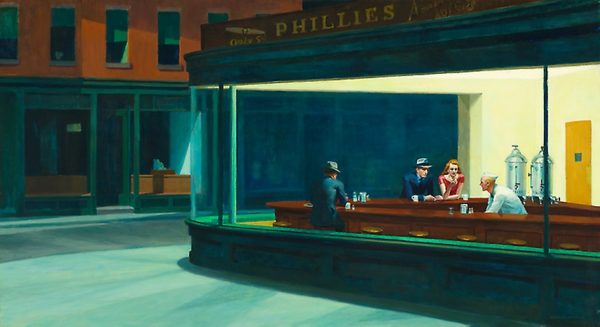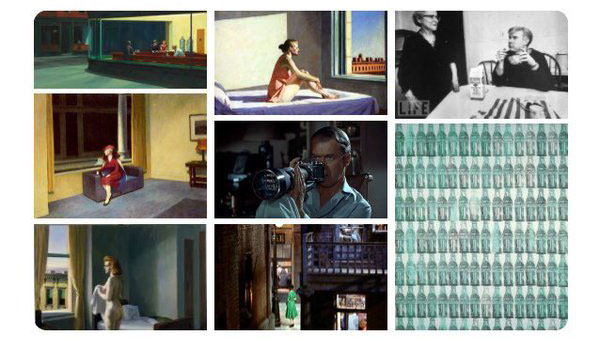A moving mixture of personal memoir and art writing, Olivia Laing’s The Lonely City looks at the topic of loneliness by weaving her own story of a rough stay in New York with the work and stories of four different NYC artists: Edward Hopper, Andy Warhol, Henry Darger, and David Wojnarowicz.
This is a book you might want to read with a laptop nearby so you can study some of the artworks that come up along the way, even something like Hopper’s Nighthawks, which you’ve probably seen dozens of times, but have you really looked? (Something I never noticed that Laing points out: there’s no visible door to the outside.)

You might also put on this YouTube playlist and pull up this pinboard to get a visual representation of some of the books’ contents:
I read this back in 2016, but I imagine it has a different and maybe even deeper resonance for readers during a pandemic. Not long after finishing the book an acquaintance of mine mentioned that she’d been alone for a couple of weeks recently and sort of forgot what it was like to function in the world, something Laing writes about:
If you are not being touched at all, then speech is the closest contact it is possible to have with another human being. Almost all city-dwellers are daily participants in a complex part-song of voices, sometimes performing the aria but more often the chorus, the call and response, the passing back and forth of verbal small change with near and total strangers. The irony is that when you are engaged in larger and more satisfactory intimacies, these quotidian exchanges go off smoothly, almost unnoticed, unperceived. It is only when there is a paucity of deeper and more personal connection that they develop a disproportionate importance, and with it a disproportionate risk.
This is one of the themes of the book: when you most need intimacy — the opposite of loneliness — not only is it nowhere to be found, but the longer you stay away from it, the less and less you are equipped to bring it about. I would also add that the times you feel like a little disconnection, it’s impossible to get it — there were several times when I was distracted from reading the book by the hollering din of my wife and kids from across the house that I thought, “Gee, a little loneliness — or at least solitude — might be nice.”
Laing quotes from The Philosophy of Andy Warhol:
At the times in my life when I was feeling the most gregarious and looking for bosom friendships, I couldn’t find any takers so that exactly when I was alone was when I felt the most like not being alone. The moment I decided I’d rather be alone and not have anyone telling me their problems, everybody I’d never even seen before in my life started running after me…. As soon as I became a loner in my own mind, that’s when I got what you might call a ‘following.’
In “Open House,” off Songs for Drella, Lou Reed sings of Warhol, “I like lots of people around me… but don’t kiss hello and please don’t touch.” Laing writes of Warhol’s use of machines to distance himself from too much intimate contact — stick a tape recorder or a camera in between you and the person you’re interacting with, and it serves as a kind of filter:

Collage comes up a lot in the book — gluing broken or different things together — and it turns out that some of Henry Darger’s process wasn’t all that different from Warhol’s:
[Darger] started with found images, sometimes backing them on card or doctoring them in subtle ways, especially by painting over them, adding hats or costumes, or simply piercing the eyes. Next, he progressed to collages, cutting images out of newspapers and magazines and pasting them into increasingly complex composites. The problem with this technique was that each component image could only be used once, meaning that he had to find more and more raw materials, either at the hospital or by going through the trash. It was wasteful of resources, and also frustrating, having to surrender a favoured image, to commit to just one picture, just one scenario.
This is where tracing came in. With tracing, he could liberate a figure or object from its past context and reuse it dozens if not hundreds of time, inserting it by way of carbon paper into a diversity of scenes. I t was economical, a thrifty process, and it also let him magically posess the image in a way that scissors didn’t, transferring it first on to tracing paper and then again through the blue sheets of carbon into the painting proper. One of his favourites was a doleful little girl holding a bucket, one finger in her mouth. Once you’ve spotted her, she crops up over and again…
I knew nothing at all about David Wojnarowicz when I first read the book. His story, and the story of how AIDS basically decimated a whole NYC subculture in the 80s and 90s, was the one I found most moving in the book. (Laing quotes a lot from his memoir, Close To The Knives, and later wrote a very moving piece about his work in Funny Weather, also putting his face on the cover.)
So, other than art, how does one combat loneliness? What types of connection should we look for? In his great review, Dwight Garner quoted Laing on checking her Twitter feed (she quit Twitter a few years ago, but her Instagram is lovely):
“It was the first thing I looked at and the last, this descending scroll from mostly strangers, institutions, friends, this ephemeral community in which I was a disembodied and inconstant presence. Picking through the litany, the domestic and the civic: lens solution, book cover, news of a death, protest picture, art opening, joke about Derrida, refugees in the forests of Macedonia, hashtag shame, hashtag lazy, climate change, lost scarf, joke about Daleks: a stream of information, sentiment and opinion that some days, most days maybe, received more attention than anything actual in my life.”
Sometimes the data stream makes her feel joyous. “At other times, though, the whole thing seemed insane, a trading-off of time against nothing tangible at all: a yellow star, a magic bean, a simulacrum of intimacy.” Civic as well as personal space has been circumscribed. Ms. Laing describes Manhattan cafes “populated almost exclusively by people gazing into the glowing clamshells of their laptops.”
It’s interesting, looking back at my notes, the few things that I took here and there for Keep Going. For example, this quote about walking from Greta Garbo, taken out of its rather dark context (Garbo was stalked and photographed by a paparazzo):
“I would rather be outside walking that to sit inside a theater and watch a picture moving. Walking is my greatest pleasure.” And again: “Often I just go where the man in front of me is going. I couldn’t survive here if I didn’t walk. I couldn’t be 24 hours in this apartment. I get out and look at the human beings.”
Laing herself sums it up: “What matters is kindness; what matters is solidarity. What matters is staying alert, staying open…”
There’s so much good stuff in the book, I can’t begin to quote it all, or explain how it all weaves together. Here are my little brick notes I took while reading:

* * *
Every Saturday I put one of my favorite books on the Bookshelf. To see more of my favorite books, check out my reading years.

